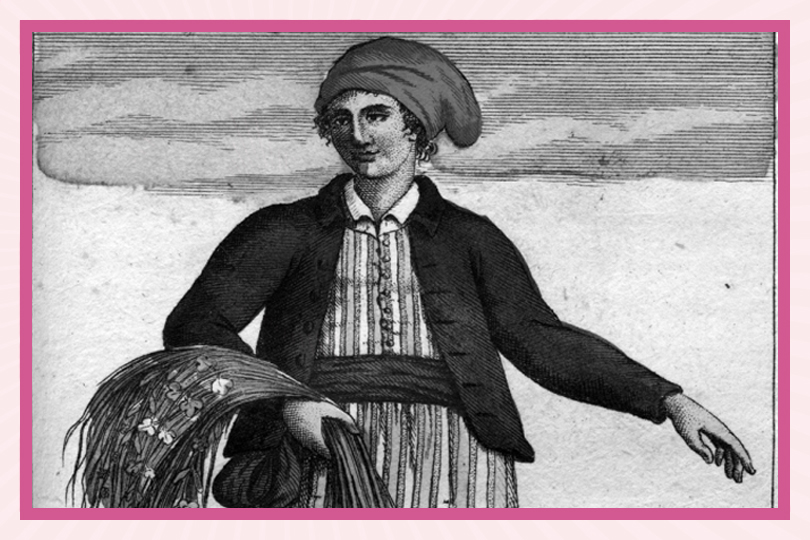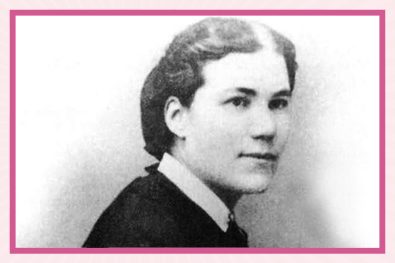By Sienna Vittoria Asselin
In 1766, a botanist named Philibert Commerçon and his assistant, introduced as Jean Baret, boarded a ship leaving France on a grand scientific expedition around the world.
Little did the 330 other male passengers on the ship know, Jean was actually Jeanne, a woman creatively disguised as a man. And as the legend goes, it would be nearly two years before they realized they had let a woman aboard—a scandalous thing, and against French law at the time.
Now, who was this bold woman? How did she end up joining this expedition as an assistant? And what did she discover during her travels? Read on for a look at the life and legacy of Jeanne Baret, an underrated historical figure who was the first recorded woman to have circumnavigated the globe.
Early years
Jeanne Baret was born in 1740 in the countryside of Bourogne, France, to “modest circumstances.” According to her biography, written by Professor Glynis Ridley, her working-class parents sold their labour each day according to the seasonal cycle of sowing, tending, and harvesting. We don’t know much about her childhood, but according to Ridley, by her early twenties she worked as the housekeeper of Philibert Commerson, a brilliant young French scientist who lived in the fashionable big city: Paris. After his wife died in 1762, Baret became his mistress.
Baret was a plant enthusiast herself and was schooled in the oral traditions of the curative properties of plants. As a “herb woman,” Baret’s usefulness caught Commerson’s attention right away and soon she was helping him with his work by organizing his papers and preparing natural specimens for him.
His career really took off when he secured a royal appointment on a global scientific voyage set to leave France in 1767. He was to be the botanist, or naturalist, on this expedition, aiding in the quest to discover new lands, plants, medicines, spices, and animal species, all for the sake of France’s attempts at building its empire.
Baret, then 26 years old, was determined to join him on the expedition.
There was only one problem: it was illegal for women to board French naval vessels. So, in a clever twist of events she decided to disguise herself as a man and put herself forward as his assistant, or his valet. Against all odds, the ruse was a success.
The expedition
They set off on December 14, 1766, with the goal of circling the globe (the first French attempt at this) and to bring back studies and samples of foreign plants and animal species. They travelled far and wide, visited several South American ports, and travelled the Straits of Magellen to enter the Pacific Ocean. They spotted penguins, seals, and dolphins, trekked through the rain forest of Madagascar and climbed the slopes of an island volcano, and witnessed many other natural wonders on their voyage—all sights that were likely quite extraordinary for someone from a poor, provincial background like Baret.
Baret and Commerson worked together throughout the expedition, and between the two of them collected more than 6,000 plant, animal, and mineral specimens. The species they collected were later brought to the National Museum of Natural History in Paris. This was an exciting time of scientific discovery, and their efforts contributed greatly to European people’s understanding of the natural world.
The discovery
Nearly two years later, in 1768, they anchored off the coast of Tahiti, an island that the French were previously unaware of. Unfamiliar with the natural beauty of the volcanic Polynesian island, the 330 passengers were simply eager to stretch their legs on land—it had been a year since they had had a leave on shore.
Until now, Baret had—according to legend—escaped the notice of the 330 men on board. But that would soon change.
According to the written account of the expedition’s commander, French navigator Louis-Antoine de Bougainville, the men shyly looked on ahead at the “Tahitian sexual freedom” that they witnessed.
The sailors, finding themselves surrounded by Tahitian women, suddenly heard a shout. They looked over and saw that a woman surrounded by Tahitian men was crying out for help. To their surprise, it was not a Tahitian woman, but one of their own. Captain Bougainville later recounted: “They have discovered that the servant of Monsieur Commerson, the doctor, was a girl who until now has been taken for a boy.”
There has since been some debate over the credibility of Bougainville’s account—to a modern reader, it seems unlikely that Baret slipped under the men’s radar for almost two years, and then was immediately recognized as a woman by the Tahitian men. Some think that this great “discovery” was later emphasized to excuse the fact that the men ignored their suspicions that there was a woman on board and didn’t bother to go through the hassle of launching an inquiry, or admit their mistake.
Later years and legacy
When the ships docked in 1768 at present-day Mauritius (then the French-controlled “Île de France”) Baret and Commerson, along with an astronomer, decided to stay on the island to continue their work. In 1773, Commerson died, it is recorded that she married a soldier named Jean Dubernat in 1774, and in 1775, they returned to France together. When she finally got off that ship, and was once again on French soil, it made her the first woman to have circumnavigated the globe. Although, nobody realized this at the time, or paid her much attention. She settled down with her new husband and they lived together in obscurity in his hometown of Saint-Aulaye until she died in 1807.
However, it seems that Baret was respected as a botanist herself by the end of the voyage; in Bougainville’s journal, he referred to Baret and Commerson together as “the botanists.” Eight years later, someone (perhaps Bougainville) successfully petitioned to secure her a government pension, making her the first woman to receive a government pension for contributing to a scientific expedition.
As mentioned above, the circumstances around Baret’s disguise and supposed discovery in Tahiti has been debated. Nevertheless, what remains is that she had to pretend to be a man in the first place in order to gain entry to this venture. Ultimately, her story is a fascinating example of the lengths that women went to in order to participate in scientific work.











